-

 30cm x 39cm. Gort Co Galway Terry Willers was a famous cartoonist and animator.Born in England in 1935 he later moved to Co Wicklow and worked extensively for the Irish Times and other publications and magazines and also on RTE. In 1992 he founded the Guinness International Cartoon Festival in Rathdrum Co Wicklow. He also won the Jacobs award for his work in Television. He died in 2011. Guinness were an original sponsor of the Galway International Oyster Festival . The Galway International Oyster Festival is a food festival held annually in Galway on the west coast of Ireland on the last weekend of September, the first month of the oyster season. Inaugurated in 1954, it was the brainchild of the Great Southern Hotel (now Hotel Meyrick) manager, Brian Collins. In 2000 was described by the Sunday Times as "one of the 12 greatest shows on earth" and was listed in the 1987 AA Travel Guide as one of Europe's Seven Best Festivals. The Galway International Oyster Festival was created to celebrate the Galway Native Oyster as it is a unique feature of Galway City & County. Hotel Manager, Brian Collins had been searching for something unique to attract more visitors to Galway in what was then, a quieter month of the year. Collins discussed the idea with the folk at Guinness and Patrick M. Burke's Bar in Clarenbridge and the first Galway Oyster Festival was created in 1954 with a whole 34 attendees. The festival was originally held in Clarenbridge village during the day and the Great Southern Hotel in Galway City at night until the mid-1980s when it grew so large, all of the festivities were held in the city centre of Galway. There was a red & white striped marquee at Spanish Arch and then at Nimmo's Pier by the Claddagh. In order to reduce ticket prices, the festival changed location to The Radisson Hotel Galway in 2009 but due to popular demand, the marquee was brought back in 2011, located in the Docks and the festival was renamed as the Galway International Oyster & Seafood Festival. In 2014, the 60th anniversary of the event, its producers, Milestone Inventive, brought it back to its original Galway City home at the aptly named Fishmarket at the Spanish Arch. The main events are two Oyster Opening Championships, the Irish Oyster Opening Championship and the World Oyster Opening Championship.Other events include a Masquerade Gala 'Mardi-Gras', a seafood trail, a silent disco and a family day featuring everything from cookery demonstrations, to jazz, to circus skills workshops.
30cm x 39cm. Gort Co Galway Terry Willers was a famous cartoonist and animator.Born in England in 1935 he later moved to Co Wicklow and worked extensively for the Irish Times and other publications and magazines and also on RTE. In 1992 he founded the Guinness International Cartoon Festival in Rathdrum Co Wicklow. He also won the Jacobs award for his work in Television. He died in 2011. Guinness were an original sponsor of the Galway International Oyster Festival . The Galway International Oyster Festival is a food festival held annually in Galway on the west coast of Ireland on the last weekend of September, the first month of the oyster season. Inaugurated in 1954, it was the brainchild of the Great Southern Hotel (now Hotel Meyrick) manager, Brian Collins. In 2000 was described by the Sunday Times as "one of the 12 greatest shows on earth" and was listed in the 1987 AA Travel Guide as one of Europe's Seven Best Festivals. The Galway International Oyster Festival was created to celebrate the Galway Native Oyster as it is a unique feature of Galway City & County. Hotel Manager, Brian Collins had been searching for something unique to attract more visitors to Galway in what was then, a quieter month of the year. Collins discussed the idea with the folk at Guinness and Patrick M. Burke's Bar in Clarenbridge and the first Galway Oyster Festival was created in 1954 with a whole 34 attendees. The festival was originally held in Clarenbridge village during the day and the Great Southern Hotel in Galway City at night until the mid-1980s when it grew so large, all of the festivities were held in the city centre of Galway. There was a red & white striped marquee at Spanish Arch and then at Nimmo's Pier by the Claddagh. In order to reduce ticket prices, the festival changed location to The Radisson Hotel Galway in 2009 but due to popular demand, the marquee was brought back in 2011, located in the Docks and the festival was renamed as the Galway International Oyster & Seafood Festival. In 2014, the 60th anniversary of the event, its producers, Milestone Inventive, brought it back to its original Galway City home at the aptly named Fishmarket at the Spanish Arch. The main events are two Oyster Opening Championships, the Irish Oyster Opening Championship and the World Oyster Opening Championship.Other events include a Masquerade Gala 'Mardi-Gras', a seafood trail, a silent disco and a family day featuring everything from cookery demonstrations, to jazz, to circus skills workshops. -
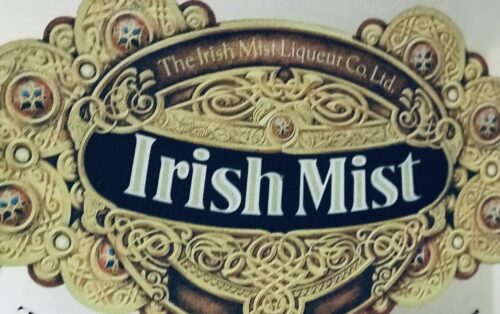
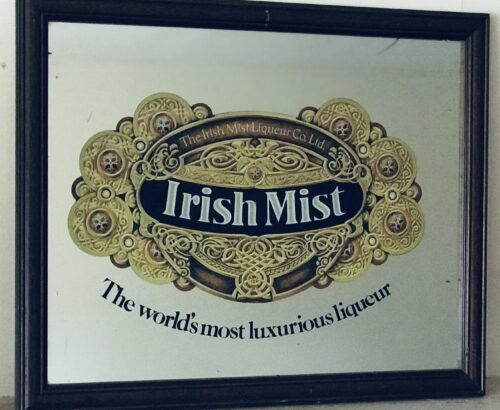 Lovely Irish Mist Pub Mirror-the Worlds Most Luxurious Liqueur Pub Mirror . Edenderry Co Offaly. 60cm x 50cm Irish Mist is a brown Whiskey Liqueur produced in Dublin, Ireland, by the Irish Mist Liqueur Company Ltd. In September 2010 it was announced that the brand was being bought by Gruppo Campari from William Grant, only a few months after Grants had bought it from the C&C Group. It is made from aged Irish whiskey, heather and clover honey, aromatic herbs, and other spirits, blended to an ancient recipe claimed to be 1,000 years old.Though it was once 80 US proof (40% alcohol per volume), Irish Mist is now 35% or 70 US proof. The bottle shape has also been changed from a “decanter” style to a more traditional whiskey bottle shape. It is currently available in more than 40 countries. Irish Mist was the first liqueur to be produced in Ireland when commercial production began in 1947 at Tullamore, County Offaly. Tullamore is the hometown of the Williams family who were the original owners of Irish Mist. The company history goes back to 1829 when the Tullamore Distillery was founded to produce Irish whiskey. In the mid-1940s Desmond E. Williams began the search for an alternative yet related product, eventually deciding to produce a liqueur based on the ancient beverage known as heather wine.In 1985 the Cantrell & Cochrane Group purchased the Irish Mist Liqueur Company from the Williams family. In the summer of 2010 Irish Mist and the entire spirit division of C&C was bought by William Grant of Scotland. In September 2010 they in turn sold Irish Mist to Gruppo Campari.Irish Mist is typically served straight up or on ice, but also goes with coffee, vodka, or cranberry juice. Per the makers, Irish Mist’s most popular recipe is Irish Mist with Cola and Lime. A Rusty Mist is an ounce of Irish Mist with an ounce of Drambuie Scotch whisky liqueur.A Black Nail is made from equal parts Irish Mist and Irish whiskey.
Lovely Irish Mist Pub Mirror-the Worlds Most Luxurious Liqueur Pub Mirror . Edenderry Co Offaly. 60cm x 50cm Irish Mist is a brown Whiskey Liqueur produced in Dublin, Ireland, by the Irish Mist Liqueur Company Ltd. In September 2010 it was announced that the brand was being bought by Gruppo Campari from William Grant, only a few months after Grants had bought it from the C&C Group. It is made from aged Irish whiskey, heather and clover honey, aromatic herbs, and other spirits, blended to an ancient recipe claimed to be 1,000 years old.Though it was once 80 US proof (40% alcohol per volume), Irish Mist is now 35% or 70 US proof. The bottle shape has also been changed from a “decanter” style to a more traditional whiskey bottle shape. It is currently available in more than 40 countries. Irish Mist was the first liqueur to be produced in Ireland when commercial production began in 1947 at Tullamore, County Offaly. Tullamore is the hometown of the Williams family who were the original owners of Irish Mist. The company history goes back to 1829 when the Tullamore Distillery was founded to produce Irish whiskey. In the mid-1940s Desmond E. Williams began the search for an alternative yet related product, eventually deciding to produce a liqueur based on the ancient beverage known as heather wine.In 1985 the Cantrell & Cochrane Group purchased the Irish Mist Liqueur Company from the Williams family. In the summer of 2010 Irish Mist and the entire spirit division of C&C was bought by William Grant of Scotland. In September 2010 they in turn sold Irish Mist to Gruppo Campari.Irish Mist is typically served straight up or on ice, but also goes with coffee, vodka, or cranberry juice. Per the makers, Irish Mist’s most popular recipe is Irish Mist with Cola and Lime. A Rusty Mist is an ounce of Irish Mist with an ounce of Drambuie Scotch whisky liqueur.A Black Nail is made from equal parts Irish Mist and Irish whiskey. -

 Fantastic vintage W.& R.Jacob & Co.Ltd Biscuit & Cake Manufacturers Dublin Advert depicting the famous Dublin Landmark which played such a pivotal role in the 1916 Easter Rising which altered the course of Irish History forever. Clonsilla Dublin 45.5cm x 57.5cm The biscuit making firm of W. & R. Jacob's were one the largest employers in the Dublin of 1916, and their factory was seized on Easter Monday by perhaps 100 members of the 2nd Battalion of the Dublin Brigade of the Irish Volunteers under Thomas MacDonagh. The factory itself was an enormous and formidable Victorian edifice located on the 'block' enclosed by Bishop St, Bride St, Peter's St and Peter's Row, and between St Patrick's Cathedral and St Stephen's Green. Its seizure helped to complete a loop of building cross the south inner city; the factory had two large towers that could act as observation points, while its location was very close to both Camden St and Patrick St: natural routeways for troops entering the city centre from Portobello Barracks in Rathmines and Wellington Barracks on the South Circular Road. There were only a few staff present in the building when the Volunteers broke into it; a number of smaller outposts were established in the area around the factory. While the garrison saw some fighting early in the week, their principal enemies proved to be boredom and the locals: the factory was surrounded by tenements, and the Volunteers were attacked and abused by residents, many of whom were Jacob's workers themselves. The families of servicemen were also quite hostile, but there may have been another reason for this hostility: Michael O'Hanrahan, who was in Jacob's, expressed his concern that the choice of location might endanger local residents if the British chose to attack. As it happens, the factory was largely by-passed, though it was fired upon intermittently throughout the week by troops in Dublin Castle and elsewhere. MacDonagh surrendered in nearby St Patrick's Park on Sunday 30 April; some of the factory was looted after the Volunteers had left. Three members of the Jacob's garrison were executed. Most of the factory was eventually demolished, though fragments of the ground storey and one of the towers are still visible on Bishop St between the DIT campus on Aungier St and the National Archives of Ireland.
Fantastic vintage W.& R.Jacob & Co.Ltd Biscuit & Cake Manufacturers Dublin Advert depicting the famous Dublin Landmark which played such a pivotal role in the 1916 Easter Rising which altered the course of Irish History forever. Clonsilla Dublin 45.5cm x 57.5cm The biscuit making firm of W. & R. Jacob's were one the largest employers in the Dublin of 1916, and their factory was seized on Easter Monday by perhaps 100 members of the 2nd Battalion of the Dublin Brigade of the Irish Volunteers under Thomas MacDonagh. The factory itself was an enormous and formidable Victorian edifice located on the 'block' enclosed by Bishop St, Bride St, Peter's St and Peter's Row, and between St Patrick's Cathedral and St Stephen's Green. Its seizure helped to complete a loop of building cross the south inner city; the factory had two large towers that could act as observation points, while its location was very close to both Camden St and Patrick St: natural routeways for troops entering the city centre from Portobello Barracks in Rathmines and Wellington Barracks on the South Circular Road. There were only a few staff present in the building when the Volunteers broke into it; a number of smaller outposts were established in the area around the factory. While the garrison saw some fighting early in the week, their principal enemies proved to be boredom and the locals: the factory was surrounded by tenements, and the Volunteers were attacked and abused by residents, many of whom were Jacob's workers themselves. The families of servicemen were also quite hostile, but there may have been another reason for this hostility: Michael O'Hanrahan, who was in Jacob's, expressed his concern that the choice of location might endanger local residents if the British chose to attack. As it happens, the factory was largely by-passed, though it was fired upon intermittently throughout the week by troops in Dublin Castle and elsewhere. MacDonagh surrendered in nearby St Patrick's Park on Sunday 30 April; some of the factory was looted after the Volunteers had left. Three members of the Jacob's garrison were executed. Most of the factory was eventually demolished, though fragments of the ground storey and one of the towers are still visible on Bishop St between the DIT campus on Aungier St and the National Archives of Ireland. -
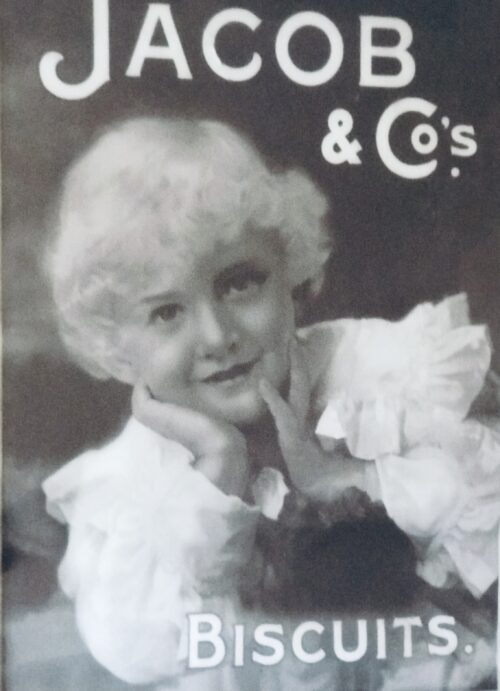
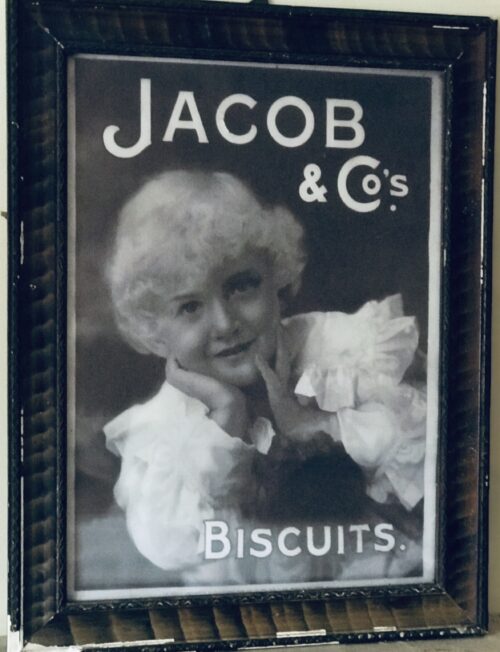 The Jacobs Biscuit Bakery originated in Waterford in 1851,after being founded by William Beale Jacob and his brother Robert.It later moved to Bishop Street in Dublin with a further factory in Peters Row.Jacobs Bishop Street premises was occupied as a strategic location by rebels during the 1916 Easter Rebellion.This charming advert depicting a rather cherubic looking young child dates to the early 1930s. Dublin 57cm x 45cm The biscuit making firm of W. & R. Jacob's were one the largest employers in the Dublin of 1916, and their factory was seized on Easter Monday by perhaps 100 members of the 2nd Battalion of the Dublin Brigade of the Irish Volunteers under Thomas MacDonagh. The factory itself was an enormous and formidable Victorian edifice located on the 'block' enclosed by Bishop St, Bride St, Peter's St and Peter's Row, and between St Patrick's Cathedral and St Stephen's Green. Its seizure helped to complete a loop of building cross the south inner city; the factory had two large towers that could act as observation points, while its location was very close to both Camden St and Patrick St: natural routeways for troops entering the city centre from Portobello Barracks in Rathmines and Wellington Barracks on the South Circular Road. There were only a few staff present in the building when the Volunteers broke into it; a number of smaller outposts were established in the area around the factory. While the garrison saw some fighting early in the week, their principal enemies proved to be boredom and the locals: the factory was surrounded by tenements, and the Volunteers were attacked and abused by residents, many of whom were Jacob's workers themselves. The families of servicemen were also quite hostile, but there may have been another reason for this hostility: Michael O'Hanrahan, who was in Jacob's, expressed his concern that the choice of location might endanger local residents if the British chose to attack. As it happens, the factory was largely by-passed, though it was fired upon intermittently throughout the week by troops in Dublin Castle and elsewhere. MacDonagh surrendered in nearby St Patrick's Park on Sunday 30 April; some of the factory was looted after the Volunteers had left. Three members of the Jacob's garrison were executed. Most of the factory was eventually demolished, though fragments of the ground storey and one of the towers are still visible on Bishop St between the DIT campus on Aungier St and the National Archives of Ireland.
The Jacobs Biscuit Bakery originated in Waterford in 1851,after being founded by William Beale Jacob and his brother Robert.It later moved to Bishop Street in Dublin with a further factory in Peters Row.Jacobs Bishop Street premises was occupied as a strategic location by rebels during the 1916 Easter Rebellion.This charming advert depicting a rather cherubic looking young child dates to the early 1930s. Dublin 57cm x 45cm The biscuit making firm of W. & R. Jacob's were one the largest employers in the Dublin of 1916, and their factory was seized on Easter Monday by perhaps 100 members of the 2nd Battalion of the Dublin Brigade of the Irish Volunteers under Thomas MacDonagh. The factory itself was an enormous and formidable Victorian edifice located on the 'block' enclosed by Bishop St, Bride St, Peter's St and Peter's Row, and between St Patrick's Cathedral and St Stephen's Green. Its seizure helped to complete a loop of building cross the south inner city; the factory had two large towers that could act as observation points, while its location was very close to both Camden St and Patrick St: natural routeways for troops entering the city centre from Portobello Barracks in Rathmines and Wellington Barracks on the South Circular Road. There were only a few staff present in the building when the Volunteers broke into it; a number of smaller outposts were established in the area around the factory. While the garrison saw some fighting early in the week, their principal enemies proved to be boredom and the locals: the factory was surrounded by tenements, and the Volunteers were attacked and abused by residents, many of whom were Jacob's workers themselves. The families of servicemen were also quite hostile, but there may have been another reason for this hostility: Michael O'Hanrahan, who was in Jacob's, expressed his concern that the choice of location might endanger local residents if the British chose to attack. As it happens, the factory was largely by-passed, though it was fired upon intermittently throughout the week by troops in Dublin Castle and elsewhere. MacDonagh surrendered in nearby St Patrick's Park on Sunday 30 April; some of the factory was looted after the Volunteers had left. Three members of the Jacob's garrison were executed. Most of the factory was eventually demolished, though fragments of the ground storey and one of the towers are still visible on Bishop St between the DIT campus on Aungier St and the National Archives of Ireland. -

 50cm x 70cm Drumcondra Dublin Once the Willy Wonka chocolate factory of Dublin,Williams & Woods kept generations of children and adults happy with their large range of confectionary items as advertised in this rare, original print from the late 1890s.The company is long gone but happily the building has been put to good use as you can read below.William's & Woods building on King's Inn Street in Dublin City Centre is where it all began - the first home to the Chocolate Factory shared creative space. Once manufacturing various sweet treats including Toblerone and Mint Crisp, this industrial building now houses an eclectic mix of small businesses and individuals in creative sectors including art, design, music, photography, craft, up-cycling, dance, illustration, graphics, events, horticulture, baking and small batch food & drink production. The incredible transformation and re-invention of Dublin's first concrete building into a creative and collaborative space continues in addition to other alternative Chocolate Factory venues around the country.
50cm x 70cm Drumcondra Dublin Once the Willy Wonka chocolate factory of Dublin,Williams & Woods kept generations of children and adults happy with their large range of confectionary items as advertised in this rare, original print from the late 1890s.The company is long gone but happily the building has been put to good use as you can read below.William's & Woods building on King's Inn Street in Dublin City Centre is where it all began - the first home to the Chocolate Factory shared creative space. Once manufacturing various sweet treats including Toblerone and Mint Crisp, this industrial building now houses an eclectic mix of small businesses and individuals in creative sectors including art, design, music, photography, craft, up-cycling, dance, illustration, graphics, events, horticulture, baking and small batch food & drink production. The incredible transformation and re-invention of Dublin's first concrete building into a creative and collaborative space continues in addition to other alternative Chocolate Factory venues around the country.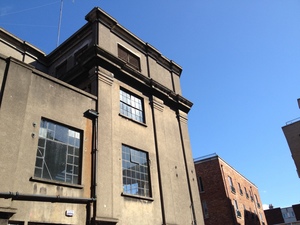
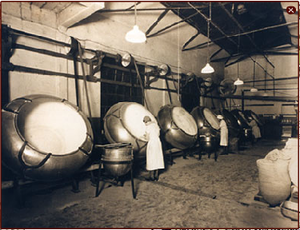
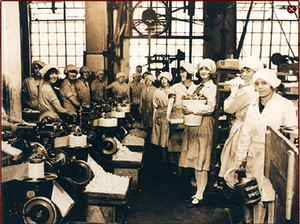
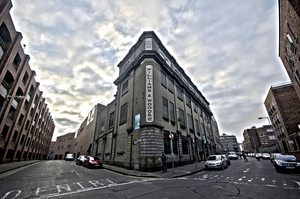 D
D
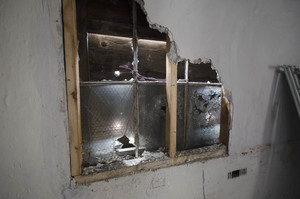
-

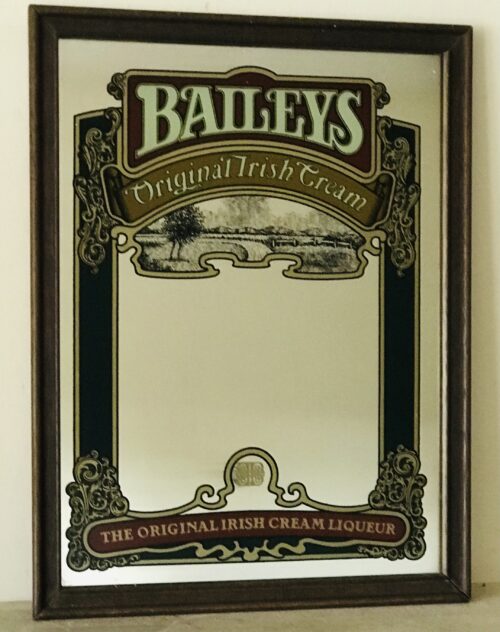 Beautiful,nicely proportioned Baileys Irish Cream Pub Mirror. 45cm x 55 cm Baileys Irish cream is an Irish whiskey and cream-based liqueur, made by Diageo at Nangor Road, in Dublin, Republic of Ireland and in Mallusk, Northern Ireland owned by Gilbeys of Ireland, the trademark is currently owned by Diageo. It has a declared alcohol content of 17% by volume. Baileys Irish Cream was created by Tom Jago of Gilbeys of Ireland, a division of International Distillers & Vintners, as it searched for something to introduce to the international market. The process of finding a product began in 1971 and it was introduced in 1974 as the first Irish cream on the market. The Baileys name was granted permission by John Chesterman after Gilbeys asked to use the name from a restaurant that John Chesterman owned. The fictional R.A. Bailey signature was inspired by the Bailey's Hotel in London, though the registered trademark omits the apostrophe. Cream and Irish whiskey from various distilleries are homogenized to form an emulsion with the aid of an emulsifier containing refined vegetable oil. The process prevents the separation of alcohol and cream during storage. Baileys contains a proprietary cocoa extract recipe giving Baileys its chocolate character and essence. The quantity of other ingredients is not known but they include herbs and sugar. According to the manufacturer, no preservatives are required as the alcohol content preserves the cream. The cream used in the drink comes from Glanbia, an Irish dairy company. Glanbia's Virginia facility in County Cavan produces a range of fat-filled milk powders and fresh cream. It has been the principal cream supplier to Baileys Irish Cream Liqueurs for more than thirty years. At busier times of the year, Glanbia will also supply cream from its Ballyragget facility in Kilkenny. The manufacturer claims Baileys Irish Cream has a shelf life of 24 months and guarantees its taste for two years from the day it was made—opened or unopened, stored in a refrigerator or not—when stored away from direct sunlight at temperatures between 0 and 25 °C (32 and 77 °F). As is the case with milk, cream will curdle whenever it comes into contact with a weak acid. Milk and cream contain casein, which coagulates, when mixed with weak acids such as lemon, tonic water, or traces of wine. While this outcome is undesirable in most situations, some cocktails (such as the cement mixer, which consists of a shot of Bailey's mixed with the squeezed juice from a slice of lime) specifically encourage coagulation. In 2003, Bailey & Co. launched Baileys Glide, aimed at the alcopop market. It was discontinued in 2006. In 2005, Baileys launched mint chocolate and crème caramel variants at 17% ABV. They were originally released in UK airports and were subsequently released in the mass markets of the UK, US, Australia and Canada in 2006. In 2008, Baileys, after the success of previous flavour variants, released a coffee variant, followed by a hazelnut flavoured variant in 2010.The company trialled a new premium variety, Baileys Gold, at several European airports in 2009. The Gold version also was marketed towards the Japanese consumer.The latest additions to the Baileys flavour family are Biscotti, launched in 2011, and a sub-brand premium product Baileys Chocolat Luxe, which combined Belgian chocolate with Baileys, in 2013. The company released a Vanilla-Cinnamon variety in the US market in 2013 with further flavours, Pumpkin Spice, Espresso and Salted Caramel launching the following year.In 2017, Baileys launched their Pumpkin Spice flavoured liqueur, also their Vegan-Friendly Baileys Almande, and in 2018 Baileys Strawberries & Cream was made available.
Beautiful,nicely proportioned Baileys Irish Cream Pub Mirror. 45cm x 55 cm Baileys Irish cream is an Irish whiskey and cream-based liqueur, made by Diageo at Nangor Road, in Dublin, Republic of Ireland and in Mallusk, Northern Ireland owned by Gilbeys of Ireland, the trademark is currently owned by Diageo. It has a declared alcohol content of 17% by volume. Baileys Irish Cream was created by Tom Jago of Gilbeys of Ireland, a division of International Distillers & Vintners, as it searched for something to introduce to the international market. The process of finding a product began in 1971 and it was introduced in 1974 as the first Irish cream on the market. The Baileys name was granted permission by John Chesterman after Gilbeys asked to use the name from a restaurant that John Chesterman owned. The fictional R.A. Bailey signature was inspired by the Bailey's Hotel in London, though the registered trademark omits the apostrophe. Cream and Irish whiskey from various distilleries are homogenized to form an emulsion with the aid of an emulsifier containing refined vegetable oil. The process prevents the separation of alcohol and cream during storage. Baileys contains a proprietary cocoa extract recipe giving Baileys its chocolate character and essence. The quantity of other ingredients is not known but they include herbs and sugar. According to the manufacturer, no preservatives are required as the alcohol content preserves the cream. The cream used in the drink comes from Glanbia, an Irish dairy company. Glanbia's Virginia facility in County Cavan produces a range of fat-filled milk powders and fresh cream. It has been the principal cream supplier to Baileys Irish Cream Liqueurs for more than thirty years. At busier times of the year, Glanbia will also supply cream from its Ballyragget facility in Kilkenny. The manufacturer claims Baileys Irish Cream has a shelf life of 24 months and guarantees its taste for two years from the day it was made—opened or unopened, stored in a refrigerator or not—when stored away from direct sunlight at temperatures between 0 and 25 °C (32 and 77 °F). As is the case with milk, cream will curdle whenever it comes into contact with a weak acid. Milk and cream contain casein, which coagulates, when mixed with weak acids such as lemon, tonic water, or traces of wine. While this outcome is undesirable in most situations, some cocktails (such as the cement mixer, which consists of a shot of Bailey's mixed with the squeezed juice from a slice of lime) specifically encourage coagulation. In 2003, Bailey & Co. launched Baileys Glide, aimed at the alcopop market. It was discontinued in 2006. In 2005, Baileys launched mint chocolate and crème caramel variants at 17% ABV. They were originally released in UK airports and were subsequently released in the mass markets of the UK, US, Australia and Canada in 2006. In 2008, Baileys, after the success of previous flavour variants, released a coffee variant, followed by a hazelnut flavoured variant in 2010.The company trialled a new premium variety, Baileys Gold, at several European airports in 2009. The Gold version also was marketed towards the Japanese consumer.The latest additions to the Baileys flavour family are Biscotti, launched in 2011, and a sub-brand premium product Baileys Chocolat Luxe, which combined Belgian chocolate with Baileys, in 2013. The company released a Vanilla-Cinnamon variety in the US market in 2013 with further flavours, Pumpkin Spice, Espresso and Salted Caramel launching the following year.In 2017, Baileys launched their Pumpkin Spice flavoured liqueur, also their Vegan-Friendly Baileys Almande, and in 2018 Baileys Strawberries & Cream was made available. -

 Superb vintage "Ask your Grocer for Shaws Limerick Bacon & Hams -A Breakfast Luxury as supplied to Royalty". 47cm x 37cm Limerick Limerick is well-known and famed for its bacon production, “everything but the squeak was used”. Many of the households in areas such as the Abbey kept pigs along with the more traditional chickens usually fed on domestic scraps as well as on root crops. Although the majority of the pigs were imported from the local environs. Thousands of pigs were slaughtered and processed weekly in the Limerick Bacon factories, who in the height of their production were the most consumed pork products in the British Isles. In the 19th century Limerick Hams became renowned throughout the British Empire with Queen Victoria insisting on Limerick hams at her Christmas dinner. Limerick pork through the O’Mara’s was even exporting as far away as Russia and Romania in 1891 and 1902 respectively. The four great bacon factories in Limerick were Matterson’s, Shaw’s, O’Mara’s and Denny’s each competing for local, national and international trade out of Limerick city during the 19th and early 20th Centuries. Other Bacon Merchants in Limerick City during this period were Hogan, Longbottom, Looney, Lynch & Spain, Neazor, O’Brien, O’Connor, O’Halloran, Prendergast, Rea, Sullivan, Thompson though this article concentrates on the four major players. The bacon industry was wrought with tragedy and some of the stories can be read on the Factory Fatalities page. Further reading on the bacon factories can be found in this issue of The Old Limerick Journal.
Superb vintage "Ask your Grocer for Shaws Limerick Bacon & Hams -A Breakfast Luxury as supplied to Royalty". 47cm x 37cm Limerick Limerick is well-known and famed for its bacon production, “everything but the squeak was used”. Many of the households in areas such as the Abbey kept pigs along with the more traditional chickens usually fed on domestic scraps as well as on root crops. Although the majority of the pigs were imported from the local environs. Thousands of pigs were slaughtered and processed weekly in the Limerick Bacon factories, who in the height of their production were the most consumed pork products in the British Isles. In the 19th century Limerick Hams became renowned throughout the British Empire with Queen Victoria insisting on Limerick hams at her Christmas dinner. Limerick pork through the O’Mara’s was even exporting as far away as Russia and Romania in 1891 and 1902 respectively. The four great bacon factories in Limerick were Matterson’s, Shaw’s, O’Mara’s and Denny’s each competing for local, national and international trade out of Limerick city during the 19th and early 20th Centuries. Other Bacon Merchants in Limerick City during this period were Hogan, Longbottom, Looney, Lynch & Spain, Neazor, O’Brien, O’Connor, O’Halloran, Prendergast, Rea, Sullivan, Thompson though this article concentrates on the four major players. The bacon industry was wrought with tragedy and some of the stories can be read on the Factory Fatalities page. Further reading on the bacon factories can be found in this issue of The Old Limerick Journal.
MATTERSON’S
 J Matterson & Sons operated out of Roches Street, while their rival company O’Mara’s operated across the road on the same street from 1839. Mattersons was established in 1816 by John Russell and J Matterson, who were brother-in-laws of a kind. Both men married a Mossop sister, Mary and Eleanor.
After the death of Joseph Matterson Snr in 1854, Joseph Matterson Jnr took over the Limerick aspect of the company. While Joseph Matterson Snr’s other son William Matterson, oversaw the London branch of the business. William Matterson died aged 71 in London in January 1903.
Not only was Joseph Matterson Jnr. a business owner in the city but he was also a key player in the community. He was vice president of the Protestant Young Mens Association which stained-glass window still remains in-situ in O’Connell Street.
Below are the funeral notices from the Limerick Chronicle, from the Limerick City Library Local Studies, for members of the Matterson Family.
J Matterson & Sons operated out of Roches Street, while their rival company O’Mara’s operated across the road on the same street from 1839. Mattersons was established in 1816 by John Russell and J Matterson, who were brother-in-laws of a kind. Both men married a Mossop sister, Mary and Eleanor.
After the death of Joseph Matterson Snr in 1854, Joseph Matterson Jnr took over the Limerick aspect of the company. While Joseph Matterson Snr’s other son William Matterson, oversaw the London branch of the business. William Matterson died aged 71 in London in January 1903.
Not only was Joseph Matterson Jnr. a business owner in the city but he was also a key player in the community. He was vice president of the Protestant Young Mens Association which stained-glass window still remains in-situ in O’Connell Street.
Below are the funeral notices from the Limerick Chronicle, from the Limerick City Library Local Studies, for members of the Matterson Family.
- Matterson, Alfred, Castletroy, Limerick Chronicle 12 August 1848, son of Joseph Matterson Snr
- Matterson, Mary, Castletroy, Limerick Chronicle 25 June 1853, aged 16, daughter of Joseph Matterson Snr
- Matterson, Anne, Castletroy, Limerick Chronicle 26 July 1854, aged 20, daughter of Joseph Matterson Snr
- Matterson, Joseph Snr, Castletroy, Limerick Chronicle 08 July 1854, provision merchant, manufacturer of Limerick Hams; int at Kilmurry church
- Matterson, Henry, Castletroy, Limerick Chronicle 23 January 1858, aged 32, son of late Joseph Matterson Snr
- Matterson, Elizabeth , Castletroy, Limerick Chronicle 24 February 1858, aged 23, daughter of late Joseph Matterson Snr
- Matterson, Henry Sutherland, 81 George Street, Limerick Chronicle 12 September 1876, aged 13 months; son of Joseph Matterson Jnr.
- Matterson, Mary, Castletroy House, Limerick Chronicle 1st June 1886 aged 82, widow of late Joseph Matterson Snr, death notice.
- Matterson, Evely Gordon, 81 George Street, 4 January 1890, death notice, aged 4 months, daughter of J. Matterson Jnr
- Matterson, Mary Gordon (Molly), Castletroy House, Limerick Chronicle 05 May 1896, aged 17, daughter of Joseph Jnr and Agnes Matterson (funeral report) (reply to condolences).
- Matterson, Joseph, Castletroy House, Limerick Chronicle 3 April 1906, (further report 1) (further report 2) (funeral report) – buried in Kilmurry Graveyard.
 In 1901 Joseph Matterson, Jnr aged 60 was living with his 46 year old wife Agnes and children Leopold (18), Vera Sunderland(9), Victor (7), Eva (5) and a seven various servants. Joseph Matterson Jnr and his wife Agnes had 12 children in total with 9 still living in 1911, married 33 years. After Joseph’s death in 1906, Agnes and family moved to the Ennis Road, her children Ian Gordon and Vera Sunderland were living with her in 1911.
The following also courtesy of Pat Mossop is a wonderful letter written by a Limerick lady in 1873: Eleanor McGhie, an article by Sharon Slater based on the letter was published in the Old Limerick Journal.
In 1901 Joseph Matterson, Jnr aged 60 was living with his 46 year old wife Agnes and children Leopold (18), Vera Sunderland(9), Victor (7), Eva (5) and a seven various servants. Joseph Matterson Jnr and his wife Agnes had 12 children in total with 9 still living in 1911, married 33 years. After Joseph’s death in 1906, Agnes and family moved to the Ennis Road, her children Ian Gordon and Vera Sunderland were living with her in 1911.
The following also courtesy of Pat Mossop is a wonderful letter written by a Limerick lady in 1873: Eleanor McGhie, an article by Sharon Slater based on the letter was published in the Old Limerick Journal.
SHAW’S
 Shaw & Sons operated out of Mulgrave Street. It was founded in 1831 by William John Shaw, whose family originated in Co. Down. In 1892 Shaw’s factory was using electric lights, lifts, a mini-railway and even telephonic communications, the Shaw’s factory was well ahead of it’s time. It is now owned by the Kerry Group.
Below are the funeral notices from the Limerick Chronicle, from the Limerick City Library Local Studies, for members of the Shaw Family.
Shaw & Sons operated out of Mulgrave Street. It was founded in 1831 by William John Shaw, whose family originated in Co. Down. In 1892 Shaw’s factory was using electric lights, lifts, a mini-railway and even telephonic communications, the Shaw’s factory was well ahead of it’s time. It is now owned by the Kerry Group.
Below are the funeral notices from the Limerick Chronicle, from the Limerick City Library Local Studies, for members of the Shaw Family.
- Shaw, Martha, Rose Cottage, Limerick Chronicle 14 April 1868, wife of William John Shaw – buried in St. Munchin’s Graveyard.
- Shaw, William John, Rose Cottage, Limerick Chronicle 02 December 1869 – buried in St. Munchin’s Graveyard
- Shaw, Harriett E., Willowbank, Limerick Chronicle 30 August 1879, second daughter of William John Shaw, Esq.
- Shaw, James Thompson, South Kensington, London, Limerick Chronicle 18th October 1892, senior partner of W. J. Shaw & Sons (further death report) (sympathy vote) (acknowledgement) – Eldest son of William John Shaw.
- Shaw, Anna Gertrude Thompson, Cheltenham 13 June 1918, daughter of late William John Shaw, Limerick.
 Alexander William Shaw – 27 October 1847 – 29 November 1923Derravoher North Circular Road,bacon curer and local politician and the founder of Limerick and Lahinch golf clubs. He was born in County Limerick, the second son of John Shaw (son of WJ Shaw) of Willowbank, bacon merchant. The family firm was already thriving when he took it over, but under his astute management it grew to become one of the largest bacon curing businesses in Europe, and Shaw became one of the most prominent businessmen in the city.
Alexander William Shaw – 27 October 1847 – 29 November 1923Derravoher North Circular Road,bacon curer and local politician and the founder of Limerick and Lahinch golf clubs. He was born in County Limerick, the second son of John Shaw (son of WJ Shaw) of Willowbank, bacon merchant. The family firm was already thriving when he took it over, but under his astute management it grew to become one of the largest bacon curing businesses in Europe, and Shaw became one of the most prominent businessmen in the city.
O’MARA’S
J. O’Mara & Sons was founded by James O’Mara who was born in Toomevara, Co. Tipperary. James O’Mara’s originally began curing bacon in the basement of his house on Mungert Street. In 1839 he moved his business to a purpose built factory on 30 Roches Street at the junction of Anne Street, across from their rival Matterson Bacon Factory. He also moved his family during this time to Hartstonge Street. The O’Mara’s factory was demolished in the late 1980s to make way for the multi-story which stands in the spot today. O’Mara’s 100 year lease on the site on Roches Street ended on 18 June 1979. Below are the funeral notices from the Limerick Chronicle, from the Limerick City Library Local Studies, for members of the O’Mara Family.- O’Mara, James, jun., Limerick Chronicle 8th July 1893, son of James O’Mara, J.P. (funeral report 10/7/1893) (2,420 Kb) – buried Mount Saint Lawrence Cemetery.
- O’Mara, Mysie, London, England, Limerick Chronicle 05/07/1898, dau of Thomas McKenna, late of Waterford; widow of late James O’Mara of Limerick
- O’Mara, James, Thomas Street, Limnerick Chronicle 20th April 1899, MD of J O’Mara & Sons bacon curers and local politician; obituary (funeral report 25/4/1899)
- O’Mara, Nannie, Alexander Terrace, L. Chronicle 28th January 1905, address that of her sister; daughter of late James O’Mara; obituary and death notice, (funeral report 31/1/1905)
DENNY’S
 Denny’s and Sons operated out of 27 Upper William Street in in 1891 as well as Mulgrave Street. It was founded by Henry Denny in the 1870s and first operated as a Provision Merchants out of Newtown Mahon, Upper William Street. Denny operated out of Limerick, Cork and Waterford. Denny’s sausages make an appearance in James Joyce’s Ulysses, where Leopold Bloom watches a young girl in Dlugacz’s butcher’s shop buy a pound and a half of Denny’s sausages, as he waits to buy a pork kidney for his and wife Molly’s breakfast. Denny’s is now owned by the Kerry Food group, after they acquired it in 1982.
Below are the funeral notices from the Limerick Chronicle, from the Limerick City Library Local Studies, for members of the Denny Family.
Denny’s and Sons operated out of 27 Upper William Street in in 1891 as well as Mulgrave Street. It was founded by Henry Denny in the 1870s and first operated as a Provision Merchants out of Newtown Mahon, Upper William Street. Denny operated out of Limerick, Cork and Waterford. Denny’s sausages make an appearance in James Joyce’s Ulysses, where Leopold Bloom watches a young girl in Dlugacz’s butcher’s shop buy a pound and a half of Denny’s sausages, as he waits to buy a pork kidney for his and wife Molly’s breakfast. Denny’s is now owned by the Kerry Food group, after they acquired it in 1982.
Below are the funeral notices from the Limerick Chronicle, from the Limerick City Library Local Studies, for members of the Denny Family.
- Denny, Abraham, Cahir, L.Chronicle 8/3/1892, death notice, involved in the bacon business in Limerick, (further death notice 8/3/1892), (funeral report 10/3/1892)
- Denny, E. M. , Kent, L. Chronicle 21/1/1905, head of Messrs Denny & Co.
-
 Cool retro ad from the 1970s with a bold and to the point message! Origins : Cork City Dimensions; 21cm x 32cm Glazed First produced in 1887, Wincarnis Tonic Wine is a natural tonic incorporating a unique infusion of herbs and spices. It’s also rich in vitamins, especially energy-giving Vitamin B complex. Usually enjoyed straight, Wincarnis Tonic Wine can also be mixed with gin to make a ‘Gin and Win’. Already a firm favourite in the United Kingdom, its export business continues to grow in Singapore, Malaysia, USA, West Indies and the UAE amongst many other markets.
Cool retro ad from the 1970s with a bold and to the point message! Origins : Cork City Dimensions; 21cm x 32cm Glazed First produced in 1887, Wincarnis Tonic Wine is a natural tonic incorporating a unique infusion of herbs and spices. It’s also rich in vitamins, especially energy-giving Vitamin B complex. Usually enjoyed straight, Wincarnis Tonic Wine can also be mixed with gin to make a ‘Gin and Win’. Already a firm favourite in the United Kingdom, its export business continues to grow in Singapore, Malaysia, USA, West Indies and the UAE amongst many other markets. -
 Framed Mantilla fine old Irish Ruby Wine Label . 21cm x 16cm Portuguese wines are the result of a succession of traditions introduced in Portugal by the various civilizations that proceeded, such as the Phoenicians, Carthaginians, Greeks and, above all, the Romans. The export of Portuguese wines began in Rome during the Roman Empire. Modern exports developed trade with the United Kingdom following the signing of the Treaty of Methuen, also referred to as the Treaty of Cloths and Wines, signed between Great Britain and Portugal in 1703.
Framed Mantilla fine old Irish Ruby Wine Label . 21cm x 16cm Portuguese wines are the result of a succession of traditions introduced in Portugal by the various civilizations that proceeded, such as the Phoenicians, Carthaginians, Greeks and, above all, the Romans. The export of Portuguese wines began in Rome during the Roman Empire. Modern exports developed trade with the United Kingdom following the signing of the Treaty of Methuen, also referred to as the Treaty of Cloths and Wines, signed between Great Britain and Portugal in 1703.

-

 Extremely rare 1950s Lucan Ice Cream Double sided Vinyl Advertising Banner . Castlegregory Co Kerry 65cm x 46cm
Extremely rare 1950s Lucan Ice Cream Double sided Vinyl Advertising Banner . Castlegregory Co Kerry 65cm x 46cm(From the Irish Times 2003 )As our best-known ice- cream factory prepares to close, Kieran Fagan tells its story - and that of one of its staff, who provided a celebrated comedy moment of the 1950s
Horses once grazed in the field where the HB ice-cream factory stands, opposite Nutgrove Shopping Centre, in Dublin. But these were working horses. For a living they pulled milk drays, leaving Hughes Brothers dairy early in the morning, knowing where to stop on their routes in south Co Dublin. The roundsmen raced from house to house, arms laden with milk bottles, while the horses ambled steadily forwards. When they were replaced by electric vans, deliveries slowed down, as the vans could not keep up as the horses had done. Nor did they know which houses to stop at.
When Paul Mulhern started work at HB, as a holiday job in 1959, 40 horse-drawn drays still delivered milk in the Dublin area. His first real job was selling ice cream to shops. Not that it was a year-round business: some winters the refrigerated containers were lifted clean off the lorries, so the vehicles could be hired out for coal deliveries.
The ice-cream business had begun as an adjunct to the dairy, in 1926. Later the operations were split. HB Ice Cream eventually became part of Unilever - the multinational group whose brands include Persil washing powder, Birds Eye frozen food and CK One perfume - growing to hold 80 per cent of the domestic ice-cream market.
In the yard of the factory now closing down, Paul Mulhern shows me an outhouse that clearly started life as a stable. It reminds him of the time in the early 1950s, eight years before he joined HB, when he was on a panel of schoolchildren on Radio Éireann's most popular programme. The School Around The Corner had come to nearby Milltown, where Paul was a pupil at the local national school. The presenter Paddy Crosbie interviewed the children, who had to sing a song, give a recitation or tell a funny story, usually of the my-granny-fell-down-the-stairs-and-we-all-laughed variety.
When Paul's turn came he started to tell a tale his father had told him on the way to the programme. "I didn't really understand it, but he said it would be OK. I think he'd had a pint or two." The story was hardly funny. The nine-year-old told how he had seen a horse bolt and fall into a hole in the road, where it had to be destroyed. Crosbie's attention was momentarily distracted by some offstage crisis. "Where they did shoot the horse?" he asked. "In the hole, sir," Paul piped up helpfully. The nation erupted. Nothing quite like it had ever been heard on Radio Éireann. "I remember my mother blushing over it," says Mulhern. "She' s still embarrassed half a century later."
HB stands for Hughes Brothers and for Hazelbrook, the name of the farmhouse that William Hughes and his wife, Margaret, built in 1896. (It has since been reconstructed in Bunratty folk park, in Co Clare.) A stream called the Hazelbrook runs through the school grounds opposite the dairy. People locally still call it the dairy, although the liquid-milk business is long gone. But it was more than just a dairy or an ice-cream factory. It was a local industry, providing jobs for up to 800 staff, mostly locals from Rathfarnham, Dundrum and Churchtown.
"When I joined, if we needed something we did it ourselves. We built our own horse-drawn drays, the bodies for the electric vans which replaced the horses, and we serviced our own vehicles," says Mulhern. He points to what remains of a motor body building workshop on the old dairy site. "And we were very early into the telesales business. In the 1960s we took orders by phone - sometimes up to 40 a day - for ice-cream cakes for birthdays and sometimes for weddings, and we delivered them."
Most travellers have noticed that familiar brands such as Cornetto and Magnum are sold in the UK as Wall's, in France as Miko and in Greece as Algida. They are international Unilever brands. But there are HB brands that are ours alone: the Golly Bar, who lost his cheeky black face to the politically correct winds of change, the Brunch and, of course, the pint brick (all of which will continue to be made here, in a venture with Lakeland Dairies).
The brick, the block of ice cream, was the mainstay of Sunday dinner - we didn't mess about with lunch then - served with a tin of fruit cocktail in good times. "Bring home a brick after Mass," the advertising slogan said, and we did. We remain faithful to the block of HB after the rest of the world has moved on.
Mulhern, who rose through the ranks to become a regional sales manager for Unilever Bestfoods Ireland, had another life outside HB. He ran for the Labour Party in two local elections and one general election, in 1979. All he will say about that is: "I didn't lose my deposit the last time."
He was more successful managing other people's campaigns. He was one of Mary Robinson's directors of elections when she won the presidency in 1990, and he is proud of that. Proud too of getting his man, Mervyn Taylor, elected in Dublin South-West in 1981 and every election thereafter until his retirement, of getting two Labour seats in 1992, and of Taylor's role in the Cabinet as a reforming minister for equality and law reform. And the subsequent success of the divorce referendum.
Taylor recalls one long and gruelling but ultimately successful count. "A group of us [Labour party workers\] sought refuge in a pub near the RDS count centre. Outside, in the hot June sunshine, I expressed a mournful longing for a Feast" - an HB ice cream - "to which I was, and still am, partial. Miraculously, at that moment, a huge HB van drove by. Paul raised his hand commandingly; the driver opened the refrigerated door and presented us with a box of Feasts. Never had ice cream tasted so good . . . . In that same election, Paul proved as adept at garnering votes as garnering ice cream."
Mulhern's retirement from the day job coincides with the plant's closure at the end of August. "There are hundreds of other lives intertwined with the life and death of HB in Rathfarnham, families raised, like mine, sometimes two and three generations from the same family who worked for the dairy," he says. "I'm proud of being part of it. Other industries will come along, other skills will develop and prosper, and in time be replaced. Few will be so closely rooted in the produce of the land and the ingenuity of its workers and be so missed."
The end of an era Frozen out by market forces
Even though HB is Ireland's leading ice-cream brand, the company says it no longer makes sense to produce ice cream at its Rathfarnham plant. Ice-cream consumption generally is falling, as consumer tastes move towards eating fewer but more expensive ice-cream products.
In one sense the HB plant is both too big and too small. It is too big for the "local products" - blocks of HB ice cream, Golly Bars, Brunches and other brands made just for Ireland - and too small to produce economically international lines such as Magnum and Cornetto for export.
It was not always so. Between 1924, when ice-cream production began, and 1964, when the founding Hughes family sold the company to W. R. Grace & Co, a US multinational, it was protected by tariffs.
In 1968, the two major dairies in Dublin, Hughes Brothers and Premier, did a historic swap. Premier took over Hughes Brothers' milk business and HB got Premier's ice-cream trade, ending up with 80 per cent of the local market. A virtually new factory, on the old Rathfarnham site, became one of Europe's most efficient ice-cream plants, with capacity far in excess of local demand. The answer was exports, particularly to Britain.
The Dutch-English Unilever, which needed to protect its position in the UK ice-cream market, bought HB in 1973. Unilever had good reason to fear Grace on its doorstep.
HB, with a brand new Irish plant, could cause it difficulties in the European market.
Tariff barriers were melting. In 1973 Ireland and Britain joined the EEC, now the EU, and HB had new opportunities on its doorstep. The agriculture subsidies for milk would keep costs down.
The HB ice-cream plant has been winding down since late last year, and the last of its 175 workers will leave next month. The local favourites will be manufactured under licence by Lakeland Dairies, the Co Cavan-based co-op, and the full range of HB products will continue to be marketed throughout Ireland.
Announcing the closure, Paul Murphy, managing director of Unilever Bestfoods Ireland, said: "The unfortunate reality is that it is no longer possible for an ice-cream manufacturing plant such as ours to compete successfully with larger-scale and more specialist Unilever plants located elsewhere on the continent."
Thus ends almost 80 years of ice-cream making in south Co Dublin.















